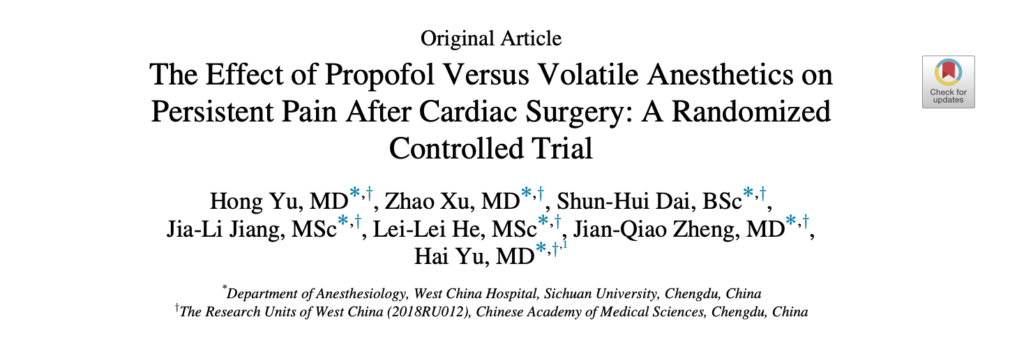Les Résumés – RFE RAAC en chirurgie cardiaque

Le résumé que vous attendiez: THE last RFE sur la RAAC en chir cardiaque
L’Actualité du Jeudi des Anesth-Réa vous propose ce mois le Résumé des dernières RFE de la SFAR sur la réhabilitation accélérée en chirurgie cardiaque sous CEC ou cœur battant!
Pour accompagner cette vignette on vous a choisi un article paru en 2020 dans The Journal of Cardiothoracic and Vascular Anesthesia; étude qui comparait les halogénés vs une anesthésie IV par Propofol sur la survenue de douleur persistante en post-opératoire de chirurgie cardiaque.
Enjoy 🤓
L’article proposé ce mois en lien avec ces RFE est paru dans le Journal of Cardiothoracic and Vascular Anesthesia en 2020 dont on vous partage l’Abstract:
https://doi.org/10.1053/j.jvca.2020.10.025
Objectives: Sternal incisions can generate persistent and intense post-sternotomy pain. Propofol has been shown to improve postoperative analgesia, but the preventive effect on persistent pain after cardiac surgery is unknown. The hypothesis of the present study was that intraoperative propofol-based anesthesia compared with volatile anesthesia could reduce the risk of chronic pain after cardiac surgery.
Design: A single-center, two-arm, patient-and-evaluator-blinded, randomized controlled trial.
Setting: A single major urban teaching and university hospital.
Patients: Five-hundred adult patients undergoing cardiac surgery via sternotomy randomly were assigned. With six withdrawals from the study and five from surgery, 244 in the total intravenous anesthesia group and 245 in the volatile group were included in the modified intention-to-treat analysis.
Interventions: Patients randomly were assigned to receive either propofol-based total intravenous anesthesia or volatile anesthesia during surgery.
Measurements and Main Results: The primary outcomes were the incidence of pain at three, six, and 12 months after surgery defined as pain score >0 on the numeric rating scale. The secondary outcomes included acute pain, opioid use during the first 72 hours after surgery, and quality of life. The use of propofol did not significantly affect chronic pain at three months (55.4% v 52.9%, difference 2.5%, 95% confidence interval [CI] 6.6 to 11.6; p = 0.656), six months (35.5% v 37.5%, difference 2.0%, 95% CI 10.9 to 6.9; p = 0.657), or 12 months (18.2% v 20.7%,
difference 2.5%, 95% CI 9.8 to 4.8; p = 0.495) compared with volatile anesthetics. Furthermore, there were no differences in acute pain score; morphine-equivalent consumption during the first 72 hours; and quality of life at three, six, and 12 months after surgery.
Conclusions: Intraoperative administration of propofol did not reduce persistent pain after cardiac surgery compared with volatile anesthetics.





 13 janvier 2022
13 janvier 2022

 Étiquettes :
Étiquettes :